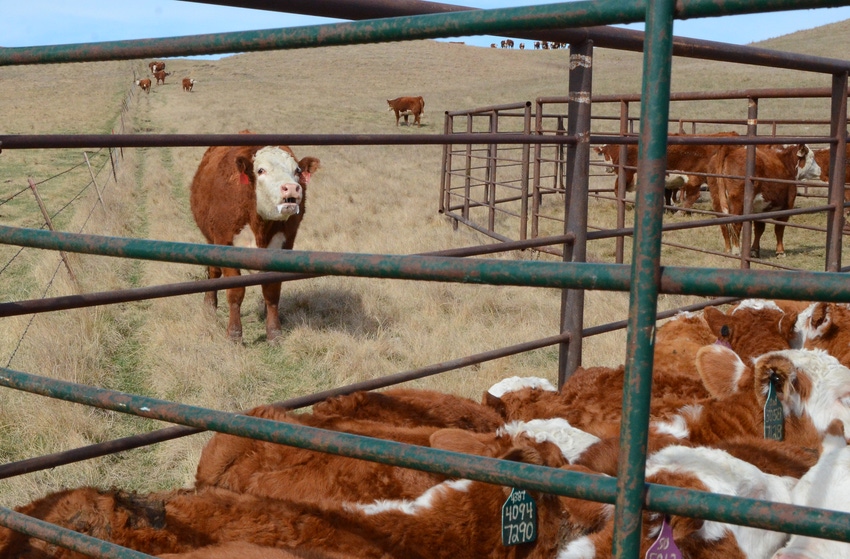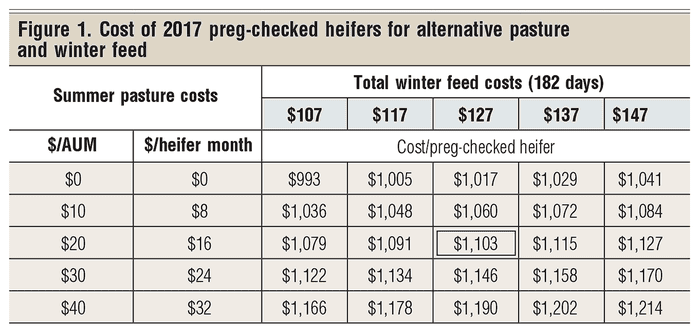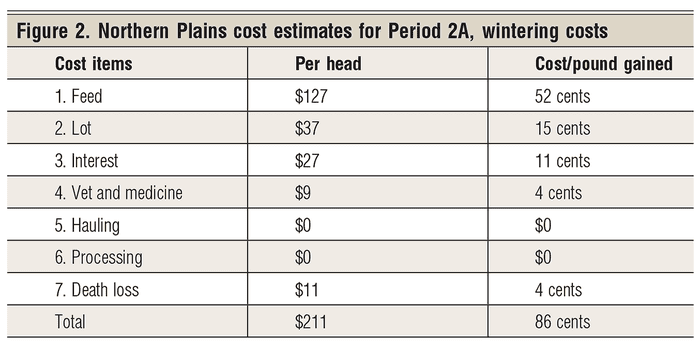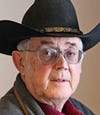The year-to-year variation in annual cost of replacement heifers is brought about by the cattle cycle and its resulting price cycle.
June 6, 2017

One of the changing annual economic costs of running a beef cow herd is the cost of raising replacement heifers. The year-to-year variation in annual cost of replacement heifers is brought about by the cattle cycle and its resulting price cycle.
To help you plan, let’s look at my current projected cost of raising preg-checked replacement heifers developed to enter my eastern Wyoming/western Nebraska study herd in the fall of 2017. These projected costs may surprise you.
I am going to use a typical spring-calving cow herd averaging 1,300-pound cows. I like to break the calculation of the cost of a replacement heifer into six steps in hopes that you can tailor these numbers to fit your own situation.
The six steps I use to calculate the replacement heifer costs are:
Period 1: Conception to weaning
Period 2: Weaning to breeding
Period 3: Breeding to pregnancy-check in the fall
Total the costs for all three periods.
Adjust total costs for heifer conception rate.
Adjust total costs for cull (open) heifer credit.

Period 1: Conception to weaning. This analysis uses heifer calves born in the spring of 2016 with a weaning date of Oct. 30, 2016, and a heifer average weaning weight of 554 pounds. The eastern Wyoming/western Nebraska market price for these calves at weaning time was calculated at $130 per cwt, generating a market value of $720 for each heifer calf entering the ranch’s heifer development program starting in November 2016.
The market value of weaned heifer calves varies greatly from year to year following the beef price cycle. In recent times, the largest cost component in the economic cost of replacement heifers is the market value of the weaned heifer calf.
That market value is the opportunity cost of not selling the heifer for cash at weaning. The opportunity cost of replacement heifers totaled over the last seven years becomes the capital investment that I use for this beef cow herd. For my study herd, it currently figures out to $1,953 per cow as of Jan. 1, 2017.
Period 2A: Wintering costs (Figure 2). This period goes from weaning through the winter feeding period, and onto grass for 30 days until the breeding date. This period tends to be the second-largest cost component in raising replacement heifers; however, this cost component can vary considerably from region to region.

The target breeding weight for these heifers is 845 pounds, 65% of mature weight. This 65% number is a subject of considerable debate — research is suggesting that perhaps it can be reduced.
The projected average daily gain (ADG) on grass is 1.5 pounds per day. This works out to an 800-pound target weight going to grass, and a winter ADG target of 1.3 pounds. The drylot winter feeding program was tailored to that target average daily gain of 1.3 pounds per day.
Figure 3 shows my estimated costs for Period 2B, wintering to grass.

Period 3: Breeding to pregnancy-check. There are three costs in this period:
Grazing costs: Grass costs are calculated from a cost of $20 per animal unit month (AUM), which is the assumed rate for a 1,000-pound animal adjusted to the actual 800-pound weight of the heifer going onto grass. This generates a pasture cost rate of $16 per heifer month, or $59 for the season. Supplement cost on grass was figured at 0.19 pounds per day, costing 30 cents per pound for a $7-per-animal cost for the grazing season.
Breeding costs: Bull costs were figured on a $5,000 heifer bull breeding 20 animals per year for four years, and then culled and sold for 85 cents per pound. The annual feed cost of the bull was estimated at $350 per year and interest cost was set at $165 per year, giving a total annual bull cost of $515. The figures out to a breeding cost of $68 per heifer.
Interest cost: Interest was figured at 5% on the $951 cost accumulated to date for 122 days, totaling $16 per heifer. Figure 4 shows estimated replacements for my study herd.

Further adjustments: Two additional adjustments are necessary:
Adjust for heifer conception rate. I need to adjust the $1,100 cost presented above for the conception rate of these heifers. I tend to use 85% conception rate for heifers, although some ranchers beat this percentage. If the $1,100 is divided by 0.85, we get an adjusted rate of $1,295 cost for each pregnant heifer.
Adjust for the value of cull heifers. An 85% conception rate leaves 15% of the heifers open that can be sold on the open market. I assumed these cull heifers would weigh 982 pounds and sell for $130 per cwt. This, then, reduces the cost of each pregnant heifer to $1,103.
Calculated heifer development costs. I frequently like to break the cost of developing a replacement heifer into the opportunity cost of the heifer calf not sold ($720, in this case) and the ranch cost of developing the heifer ($383, in this case).
In summary, I project the total economic cost of raising a replacement heifer that will enter my study herd on Oct. 30, 2017, is $1,103 per preg-checked heifer (boxed number in Figure 1); on the other hand, the actual cash flow cost of each replacement heifer is $383 per preg-checked heifer. Which number I use in my budget preparations depends of the type of budget — economic cost or cash-flow cost.
Remember, I have to cash-flow each and every year, and I have to make an economic profit some of the years. Over the nine to 11 years of a cattle cycle and its resulting price cycle, I have to both cash-flow and make a profit. Easier said than done.
I know heifer development costs can vary substantially between regions. In an attempt to make my cost estimates apply to a larger number of different ranchers, I have tried to generalize these numbers.
Figure 1 presents alternative heifer replacement costs, depending on the alternative winter feed costs and alternative summer pasture costs.
For example, total feed costs can vary from $107 to $147 for winter costs, and summer grazing costs can vary from a no-charge situation frequently assumed by some for owned grass to $40 per AUM rental grass charges. The numbers in the respective cells give the suggested cost of replacement heifers for the appropriate alternative winter feed cost and alternative summer pasture cost situation.
Hughes is a North Dakota State University professor emeritus. He lives in Kuna, Idaho. Reach him at 701-238-9607 or [email protected].
About the Author(s)
You May Also Like





